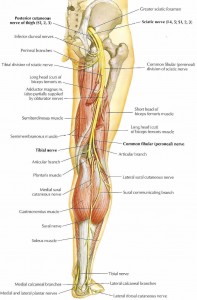The term sciatica describes the symptoms of leg pain and possibly tingling, numbness or weakness that originates in the lower back and travels through the buttock and down the large sciatic nerve in the back of the leg.
 Sciatica (pronounced sigh-at-ih-kah) is a symptom of an underlying medical condition – it is not a medical diagnosis in and of itself.
Sciatica (pronounced sigh-at-ih-kah) is a symptom of an underlying medical condition – it is not a medical diagnosis in and of itself.
Sciatica is often characterized by one or more of the following symptoms:
- Constant pain in only one side of the buttock or leg (rarely can occur in both legs)
- Pain that is worse when sitting
- Burning or tingling down the leg (vs. a dull ache)
- Weakness, numbness or difficulty moving the leg or foot
- A constant pain on one side of the rear
- A sharp pain that may make it difficult to stand up or to walk
Pain is caused when the sciatic nerve roots are irritated, scraped, twisted, stretched or pinched as they exit the spine. Causes of the impairment may be chemical, physical or the emotional stress of everyday living. A -blown sciatic flare-up can involve the
entire sciatic nerve path resulting in symptoms of lower back pain, burning, cramping or numbness that radiates into the thighs, legs, ankles, feet and toes. Pain may also be limited to various points along the nerve, such as the buttocks, knee area and calf.
One of the most common causes of sciatic leg pain is the Vertebral Subluxation Complex.
It can be accompanied by the bulging or herniation of the soft pulpy discs which separate each spinal bone. This can irritate or put pressure on the sciatic nerve roots as they leave the spinal cord. The result can be an intense pain shooting down either or both legs.
In the past, treatment has involved pain medications, muscle relaxers, physical therapy, and even surgery. The chiropractic approach is to use carefully directed and controlled pressure to remove the interference from spinal structures.
These chiropractic adjustments can be quite effective in reducing nerve irritation and its associated pain.
Sciatica, like other health problems that can be traced to the spine, often respond dramatically to the restoration of normal spinal function through conservative chiropractic care.
